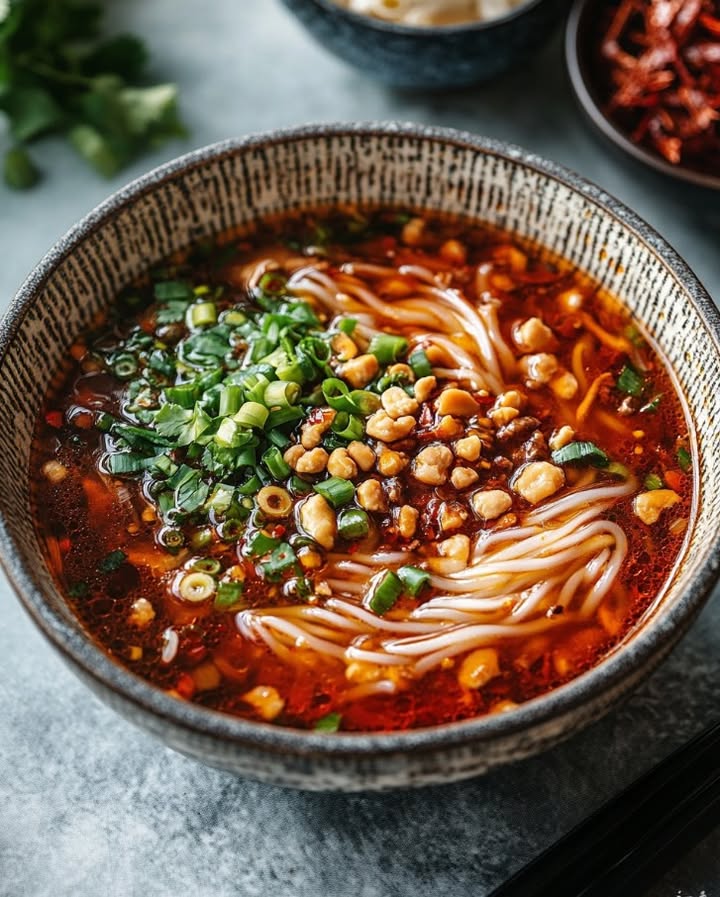
Discover the Magic of Spicy Sour Noodles: A Comforting Bowl of Sichuan Flavor
There’s something magical about a steaming bowl of Spicy Sour Noodles. It’s like a warm hug for your taste buds, with bold flavors that dance between tangy, spicy, and savory. I remember the first time I tried this dish at a tiny Sichuan restaurant in San Francisco. The heat made my nose tingle, but the sourness cooled it down just enough to keep me coming back for more. When I got home, I knew I had to recreate it. After several tries (and some very red faces), I nailed the recipe. Now, it’s a family favorite that never fails to impress.
The Origins of Spicy Sour Noodles: A Sichuan Delight
Spicy Sour Noodles, or Suan La Fen 酸辣粉, hail from China’s Sichuan province, known for its fiery cuisine. This dish combines two signature elements of Sichuan cooking: ma la (numbing spiciness) and suan la (sour spiciness). Traditionally, it’s made with sweet potato or potato starch noodles, which have a chewy texture that holds up beautifully in soups. While street vendors in Chengdu serve it with bold, punchy flavors, modern versions often add extra garnishes like peanuts and pickled vegetables for crunch and freshness.
Why You’ll Love This Recipe
This recipe is all about balance. The tangy vinegar cuts through the richness of the broth, while the chili paste adds just enough heat to keep things exciting. Plus, it’s incredibly easy to make—perfect for busy weeknights or when you’re craving comfort food without spending hours in the kitchen. Whether you’re a spice lover or just dipping your toes into bold flavors, this dish is customizable to suit your taste.
Perfect Occasions to Whip Up Spicy Sour Noodles
Need a quick lunch? Done. Hosting friends for dinner? Serve these noodles as a starter or main course. They’re also ideal for cold winter nights when you need something hearty to warm you up. If you’re looking to impress guests with an exotic dish, this one will do the trick. Trust me, once they take their first bite, they’ll be hooked!
Ingredients for Your Spicy Sour Noodle Adventure
- 200 g sweet potato or potato starch noodles
- 2 tablespoons vegetable oil
- 2 cloves garlic, finely chopped
- 1 tablespoon chili paste (adjust to taste)
- 1 tablespoon light soy sauce
- 1 tablespoon Chinese black vinegar (Chinkiang)
- ½ teaspoon ground Sichuan peppercorn
- 500 ml chicken or vegetable broth
- 1 teaspoon sugar
- Salt, to taste
- Garnishes: chopped green onions, fresh cilantro, roasted peanuts, optional pickled vegetables
Substitution Options for Flexibility
If you can’t find sweet potato noodles, regular rice noodles work too. Swap the chicken broth for vegetable broth to make it vegetarian-friendly. For those who can’t handle too much spice, reduce the chili paste and skip the Sichuan peppercorns. Instead of black vinegar, try rice vinegar—but note that the flavor won’t be quite as deep.
Step 1: Preparing the Noodles
Start by cooking the noodles according to the package instructions until they’re tender but still chewy. Once cooked, drain them and rinse under cold water. This stops the cooking process and keeps the noodles from sticking together. Set them aside for now. Pro tip: Don’t overcook the noodles—they should retain a bit of bounce to hold up in the soup.
Step 2: Building the Soup Base
In a medium-sized pot, heat the vegetable oil over medium heat. Add the minced garlic and sauté until fragrant—about 30 seconds. Be careful not to burn it; burnt garlic can ruin the entire dish! Next, stir in the chili paste and let it sizzle for another minute. The aroma will instantly transport you to a bustling Sichuan market.
Step 3: Adding Flavorful Seasonings
Pour in the soy sauce, black vinegar, Sichuan peppercorn powder, broth, sugar, and a pinch of salt. Bring the mixture to a boil, then lower the heat and simmer for about 5 minutes. During this time, the flavors meld together, creating a rich, complex broth. Chef’s tip: Taste the broth before serving and adjust the seasoning if needed. Sometimes a splash more vinegar or a dash of sugar makes all the difference.
Step 4: Assembling the Dish
Divide the cooked noodles evenly into two bowls. Ladle the hot soup over the noodles, ensuring they’re fully submerged. This step is crucial because the noodles soak up the broth, becoming even tastier.
Step 5: Garnishing and Serving
Now comes the fun part—garnishing! Sprinkle chopped green onions, fresh cilantro, and crushed roasted peanuts on top. If you have pickled vegetables, toss them in for added tanginess. Serve immediately while everything is piping hot. Watching everyone dig in is half the joy of making this dish!
Timing Breakdown for Busy Cooks
Preparation Time: 10 minutes
Cooking Time: 15 minutes
Total Time: 25 minutes
This recipe is perfect for those who want delicious results without spending hours in the kitchen.
Chef’s Secret for Elevating Your Noodles
Toast your Sichuan peppercorns lightly in a dry pan before grinding them. This intensifies their numbing, citrusy flavor, adding an authentic touch to your dish.
An Interesting Tidbit About Sweet Potato Noodles
Sweet potato noodles are naturally gluten-free, making them a great option for those avoiding wheat. Plus, they have a unique translucent appearance that looks stunning in soups.
Necessary Equipment for Making Spicy Sour Noodles
You don’t need fancy tools here—a medium pot, colander, sharp knife, cutting board, and bowls are all you need. A small mortar and pestle come in handy for crushing peanuts and peppercorns, but they’re not essential.
How to Store Leftovers Properly
If you happen to have leftovers (unlikely, but possible!), store the broth and noodles separately in airtight containers. Refrigerate them for up to three days. Why separate? The noodles absorb liquid quickly and can become mushy otherwise.
Reheat the broth on the stovetop until hot, then add the noodles and warm them gently. Avoid microwaving, as uneven heating can affect the texture.
For longer storage, freeze just the broth in freezer-safe bags or containers. Thaw overnight in the fridge before reheating. Note that freezing isn’t recommended for the noodles, as they lose their chewiness.
Tips and Advice for Perfect Spicy Sour Noodles
Use high-quality ingredients like real Sichuan peppercorns and authentic black vinegar. These small details elevate the dish significantly. Also, prep all your ingredients beforehand—it makes the process smoother and faster.
Presentation Ideas That Wow
- Serve in colorful ceramic bowls for a pop of visual interest.
- Arrange garnishes neatly on top for a professional look.
- Add edible flowers for a gourmet touch.
Healthier Alternatives to Try
Low-Sodium Version: Use low-sodium broth and reduce the soy sauce.
Vegan Option: Stick to vegetable broth and ensure all sauces are plant-based.
Gluten-Free Twist: Opt for tamari instead of soy sauce.
Less Spicy Variant: Cut back on the chili paste and omit the peppercorns.
Protein Boost: Add tofu, mushrooms, or shredded chicken.
Vegetable-Packed Bowl: Throw in spinach, bok choy, or bean sprouts for extra nutrition.
Mistake 1: Overcooking the Noodles
Overcooked noodles turn mushy and lose their delightful chewiness. Always follow the package instructions carefully and check for doneness a minute early. Pro tip: Rinse the noodles with cold water after draining to stop the cooking process.
Mistake 2: Burning the Garlic
Burnt garlic tastes bitter and ruins the soup base. Keep the heat moderate and watch closely as you sauté. Stir constantly to distribute the heat evenly.
Mistake 3: Skipping the Simmer
Rushing the simmering step means the flavors won’t develop fully. Patience pays off here—let the broth simmer for at least five minutes to achieve maximum depth.
Frequently Asked Questions About Spicy Sour Noodles
Where Can I Find Sweet Potato Noodles?
Sweet potato noodles are available at most Asian grocery stores or online retailers like Amazon. Look for packages labeled “glass noodles” or “sweet potato vermicelli.”
What Is Black Vinegar?
Black vinegar, also known as Chinkiang vinegar, is a dark, slightly sweet vinegar used in Chinese cuisine. It has a milder acidity compared to Western vinegars and adds a rich umami flavor to dishes.
Can I Make This Recipe Ahead?
While best served fresh, you can prepare components ahead of time. Cook the noodles and make the broth separately, then combine when ready to serve.
Is This Dish Gluten-Free?
Yes, if you use gluten-free soy sauce or tamari and ensure all other ingredients are free of gluten.
How Do I Adjust the Spice Level?
Control the heat by adjusting the amount of chili paste and Sichuan peppercorns. Start with smaller amounts and increase gradually until you reach your desired level of spiciness.
What Are Some Common Garnishes?
Green onions, cilantro, roasted peanuts, sesame seeds, and pickled mustard greens are popular choices. Each adds a different texture and flavor dimension.
Can I Substitute Chicken Broth?
Absolutely! Vegetable broth works well for vegetarians, while beef or mushroom broth offers alternative meaty flavors.
Do I Need Special Tools?
Nope! Just basic kitchen tools like a pot, knife, and bowls will suffice. A mortar and pestle help crush spices, but they’re optional.
Why Does My Broth Taste Flat?
If the broth lacks depth, try adding a splash more vinegar, a pinch of sugar, or a bit of soy sauce. Balance is key in this dish.
How Long Can I Store Leftovers?
Store the broth and noodles separately in the fridge for up to three days. Reheat gently on the stovetop for best results.
Wrap-Up: Dive Into the World of Spicy Sour Noodles
There’s nothing quite like the thrill of mastering a new recipe, especially one as flavorful and satisfying as Spicy Sour Noodles. With its vibrant mix of spicy, sour, and savory notes, this dish is sure to become a staple in your kitchen. So grab your apron, gather your ingredients, and get ready to create a meal that’s as comforting as it is delicious. Happy cooking!

